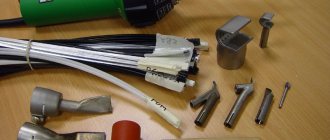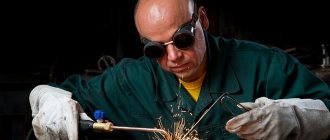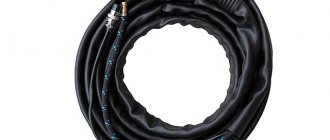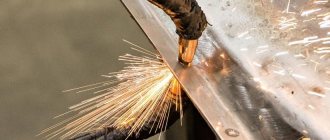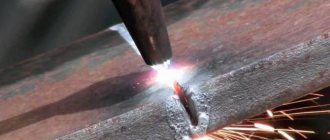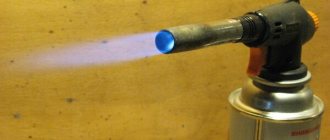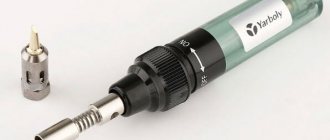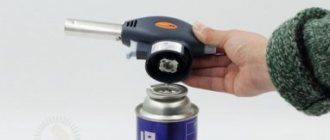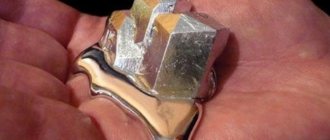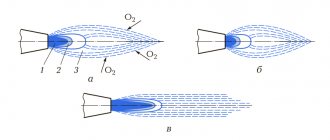Operating principle and features
The user receives an even torch, the power of which is controlled by a special valve. Due to this, the temperature at which it heats up changes depending on the thickness of the material and the tasks being pursued.
The device is more cost-effective for welding and cutting than massive, expensive equipment.
The range of uses is so wide that the product is even used for disinfecting wooden hives, treating animal cages, roofing, and so on..
The burner is ignited with matches, a lighter or an open fire source. This option is cheaper than models with installed piezo ignition. This element leads to combustion after pressing the button, which provokes the appearance of a spark, which ignites the gas jet.
A burner is a popular tool, so developers strive to improve the design and increase functionality. The market offers several types of such equipment:
- Gas soldering iron.
- Cutter.
- Burner for tourism.
- Blowtorch.
A blowtorch is one of the types of burners . Shows high temperature and is used for processing metal, plastic and other durable materials.
Each type differs in appearance (design, color , packaging) and purpose. These features are taken into account before purchasing, since this directly determines the final result of processing and ease of use.
Kinds
A burner is a popular tool, so developers strive to improve the design and increase functionality. The market offers several types of such equipment:
- Gas soldering iron.
- Cutter.
- Burner for tourism.
- Blowtorch.
A blowtorch is one of the types of burners . Shows high temperature and is used for processing metal, plastic and other durable materials.
Each type differs in appearance (design, color , packaging) and purpose. These features are taken into account before purchasing, since this directly determines the final result of processing and ease of use.
What does it depend on?
The burner temperature is determined by the chemical composition of the gas and the power of the product. During the research, it was possible to establish that the temperature parameters of the torch depend on the calorific properties of the gas mixture.
After combining the fuel with air, the gas is consumed critically, so the combustion intensity increases. By using an additional air source, you can increase the temperature you get at the burner. Without blowing, the value reaches 1500 degrees; access to auxiliary air flow gives an increase of up to 2200 degrees. The temperature differs in different parts of the torch :
- Internal . This is a short zone with little heating.
- Average . In this area, the temperature of the flame from the gas burner reaches its limit, but the fire does not open completely, which is due to a lack of oxygen and the release of decay products.
- Bordering . Visually characterized by a bright fire with high efficiency.
Cheap burner models are structurally the same. Expensive ones are equipped with additional elements that increase technical characteristics and ease of use.
To perform welding and cutting, special requirements are placed on the composition of the gas mixture, since the temperature regime of the product depends on it.
Dependence of temperature on fuel type
For domestic needs, two types of gas are used: natural and liquefied. Both of them are a transparent, explosive substance without color or odor. Therefore, to increase safety and the possibility of instant leak detection, ethyl mercaptan is added to the gas - a substance whose tart smell is felt by a person when he opens the gas tap. According to its chemical composition, natural gas consists of 98% methane and 2% of impurities that are represented sulfur, nitrogen and carbon dioxide.
In private homes, dachas and in areas not equipped with a main gas pipeline, liquefied bottled gas is used. For this, two types of mixture are used: propane-butane with a ratio of 65/35 and butane-propane prepared in a ratio of 85/15. The flame temperature of bottled gas is slightly lower than that of natural gas, and never exceeds 1000 degrees.
Due to the difference in temperatures, each gas has its own gas equipment. However, many manufacturers of gas stoves running on natural gas equip them with jets and reducers necessary to convert the stove to bottled gas. If the stove is connected to a cylinder without these important devices, the burner will begin to emit a huge amount of soot and constantly go out.
In this case, you will need to immediately contact the gas service and under no circumstances switch the stove to another type of gas yourself.
Temperature conditions of different types of burners per cylinder
You can purchase a burner online or at a hardware store. It is better to give preference to the second option, since the buyer can consult with an experienced seller, he will select the appropriate option depending on the tasks set by the user. The product range includes models that differ in temperature conditions:
- Refillable. They are characterized by small dimensions and thoughtful shape, as well as ease of use and a piezoelectric element. This type does not apply to the cylinder variety of gas burners.
- On a collet can. They are a source of powerful flame with an average outlet temperature of 1500 degrees.
- Threaded. Propane accounts for the lion's share of the fuel, due to which the temperature in the combustion zone is 1800 degrees. Advanced models are equipped with systems for mixing air with a propane mixture.
Some burners are equipped with autonomous heating of the combustible mixture, which increases the angle of use.
Adjustment
The cleanliness of the cut depends on the correct flame setting . Oxygen treatment is carried out with a slightly oxidized or normal torch. The carefully adjusted flame of cutters with concentric nozzles is surrounded by a cutting stream of oxygen. The core of the torch in each section should be symmetrical and not differ in brightness.
Cutting with a torch with the mouthpiece moved cannot be carried out, as this will lead to heating of the edge, which will negatively affect the quality of the cut. The use of self-centering mouthpieces increases the ease of use of such equipment, because the device makes the flame symmetrical.
Recommendations for work
Gas burners function as an autonomous source of large thermal energy . By regulating power and adjusting temperature conditions, the scope of application of the device is significantly expanded, it includes:
- processing of fusible metals (burning, calcination, heating) - using a directional torch with a temperature of at least 1500 degrees;
- working with wood - creating patterns, firing finished products;
- tourist purposes - you can give preference to compact models with low temperature parameters.
When using a gas burner, it must be taken into account that a lack of oxygen leads to heat losses and the accumulation of decomposition products from the combustion of the gas mixture. These phenomena provoke the appearance of soot and excessive glow, which affects the quality of cutting, welding, and melting.
Flame temperature of a conventional gas stove.
The flame temperature in conventional stoves found in kitchens depends on the type of fuel (gas) used. It is allowed to use methane (G20) and propane-butane (G30) as fuel in household stoves. The type of fuel the stove runs on can be determined by the nameplate on the rear panel. The flame temperature of methane is about 1900 °C, propane-butane is about 3000 °C.
To understand what temperature the gas burns in the burner, you need to remember what exactly is burning. And natural gas burns. Its combustion temperature may vary depending on the distance at which you record the temperature. At the burner itself it will not be high - about 300-400 degrees. But at the peak the temperature can reach up to 1500 degrees. Celsius.
But when you cook on a burner, you need to take the average value (you don’t hold the pan over the burner) - about 800 degrees.
- Compared to the flame temperature of a match (750 - 850 degrees), a match head (1500 degrees), a cigarette (700 - 800 degrees), an alcohol lamp (900 - 1300 degrees), or a candle (800 - 1400 degrees) the temperature on the burner of a household gas stove about the same or slightly higher.
- Natural gas (a mixture of propane 15-35% and butane 65-85%) allows us to obtain a flame temperature on a gas stove burner from 800 to 1000 degrees Celsius, sufficient for cooking on household stoves in containers with a capacity of up to 20-40 liters, In this case, soot and soot are formed in small quantities.
- The temperature in the oven, depending on the settings, can vary from 100 to 300 degrees Celsius.
- Compared to the burner of a household stove, a gas burner (for glassblowing or for cutting and welding metal) has a flame temperature from 800 to 1900 or from 800 to 3150 degrees, depending on the nature of the gas and the settings for the supply of combustible gas and air. By using pure oxygen and acetylene in the gas burner flame, high temperatures of up to 3150 degrees Celsius can be achieved.
It depends on what kind of gas it is. Gas from gas cylinders, which are used to prepare food, for example in dachas. Or main gas. Although, in principle, they differ not so significantly in temperature. The hottest flame is at the end of its “tongues”. And its temperature exceeds 1000-1200 degrees. In the middle is a flame of medium temperature. Its indicators are 600-800 degrees. And the “coldest” flame is directly next to the gas burner. Its temperature is approximately 400 to 600 degrees Celsius.
Experiments by scientists have shown that the temperature of such gas can reach 900 degrees . This gas on the stove has its own specifics, due to the fact that it has its own composition and components, the main one of which is methane, and the gas itself is called natural.
Highest flame temperature
This indicator determines the cutting speed of the material and is determined by the properties of the gas-air mixture and the type of fuel. A high value is guaranteed by acetylene; the substance rapidly heats the metal to melt . At the tip of the fire the temperature reaches about 3000 degrees. The farther from this point, the smaller the number.
Welder of the highest category of Progress LLC Degtyarenko V.O: “The increased temperature of the torch also has negative consequences: melting of some of the edges of the workpiece. For this reason, acetylene does not produce the same cutting quality as kerosene or gasoline vapors.”
Gas burner on a can flame temperature
December 17, 2015
Gas burners are an indispensable assistant in the household, workshops and production shops, on a picnic and on hikes. Ease and ease of use have long given the primacy to gas appliances over other types. When choosing a burner, you should take into account the scope of application, the required power, as well as the maximum flame temperature. The last factor is especially important when performing more delicate types of work. Therefore, it is necessary to know the basic parameters directly related to the temperature distribution of the gas burner flame.
What determines the temperature of a gas burner flame?
A gas burner in a can and the flame temperature in it directly depends on the composition of the gas fuel, the ambient combustion conditions and the power of the equipment used. In this case, a direct relationship is observed between the calorific value of the gas and the temperature of the flame torch - an increase in the first indicator leads to an increase in the second.
When the process of mixing the fuel used with air occurs, the gas is completely consumed, which in turn increases the burning rate and increases the flame temperature. This indicator can be improved through additional use of air blast. For example, without the use of blowing, the maximum temperature regime is 1500 °C, but when using it, results up to 2200 °C are possible.
The temperature is also affected by the flame pattern. It is not homogeneous and is divided into three zones:
Design features and operating principle
Burners vary in design - from basic devices with a nozzle to more complex mechanisms equipped with an air supply device and piezo ignition.
Let's consider the design of a torch designed for welding metal.
The design with an injector and check valve increases work productivity and reduces fuel consumption.
Almost all portable household appliances belong to the so-called injection burners, when air is naturally sucked into the burner to support the flame.
Inside, in a special chamber, fuel is mixed with air, as a result of which the fuel ignites after a spark is given.
From the mixing chamber, the mixture of gases enters the nozzle-nozzle, where it is distributed through the channels. At the end of the structure, at the point where the torch is formed, there are fire holes - the ends of the channels.
Temperature conditions of different types of burners per cylinder
You can choose a gas burner for a cylinder in specialized stores or use the online purchasing service. This significantly saves time, and on the online store page everyone has the opportunity to get acquainted with the information they are interested in about the product. The Pathfinder brand provides a huge selection of special equipment and gas burners, among others. Among them, the following three types are distinguished:
- refillable - they have a compact size and ergonomic design, are simple and easy to use, and the presence of an automatic piezoelectric ignition function allows instant use of the device. In addition, it is worth noting that this particular type does not belong to the cylinder series of gas burners;
- threaded - have a directional source of fire with a torch structure. Mixtures with a high propane content are used as fuel, which ensures that the temperature in the main flame zone is maintained at a constant temperature of about 1800 °C. Some models have separate gas and air mixture control systems. This allows you to get a fire torch of different power and the ability to perform work in a wide range of temperatures;
- with a collet cylinder – used as a source of directed flame with a torch structure, the temperature of which reaches 1500 °C.
The devices are equipped with a piezoelectric ignition system, some have the function of additional fuel heating, which allows the use of the equipment at different angles. Gas consumption ranges from 50 to 250 g/hour.
Rexant GT-19
- Fuel type – propane-butane mixture.
- The connection is collet.
- Flame temperature – 1400 ºС.
- Gas consumption – 80 g/hour.
- Overall dimensions – 153x40x57 mm.
- Weight – 135 g.
Rexant GT-19 is a compact and convenient burner designed for connection to standard gas cylinders using a collet connection. The model can be used for a variety of jobs involving flame processing, including removing old paint, lighting fires, barbecues and stoves, soldering pipe connections, and insulating wires using heat-shrinkable materials. Thanks to the built-in piezoelectric element, ignition is carried out with one touch.
After two minutes of warming up, the burner can be held at any angle, based on the characteristics of the work being performed. The design provides the ability to adjust the flame, which ensures economical fuel consumption. Recommended continuous operation time is no more than 30 minutes. It should be remembered that the burner is a subject of increased fire hazard. It is prohibited to be transported on public transport or left unattended while working. During operation, the device requires minimal human intervention. Maintenance comes down to periodically cleaning the burner from contaminants that could lead to clogging of the nozzle.
Schematic representation of a gas burner flame
The first step is to figure out what parts the burner flame consists of. This can be done using the simple diagram below.
In this schematic diagram, the following flame areas are indicated by letters:
- O – area of oxidizing flame; here the air-gas mixture burns completely, and an increased oxygen content is observed.
- B – recovery area. Here the gas does not burn completely, since it does not have enough oxygen for this. As a result, it breaks down into molecules that are combustion products. It is they who burn out completely in the oxidizing flame.
- A is the area in which the formation of the air-gas mixture occurs. Here the combustion process does not occur at all.
The numbers on the diagram are intended to indicate areas with different flame temperatures. The latter increases in regions, starting from region A and ending with the reducing part of the flame. In the process of complete combustion of gas, it decreases slightly:
- Areas 1-4. At the very bottom the temperature is 300 degrees and rises first to 320 and then to 520 degrees. In the area indicated by the number 4, it reaches a value of 1540 degrees.
- Areas 5-8. Here the temperature is 1550-1560 degrees in the center and 450 degrees at the edges. The maximum value of 1570 degrees can be observed at the very tip of the reducing part of the flame.
- 9 is an oxidizing flame, the temperature of which reaches 1540 degrees.
Rating of gas burners for soldering and repair
1st place – mini gas burner with soldering attachment
Designed for both heating medium-sized parts and for contact soldering due to the heating of the tip from the flame. A kind of soldering iron without wires. The gas tank capacity is 8ml. The flame temperature when filling with butane reaches 1300 degrees Celsius, and the tip temperature – 450 degrees. The flame length is adjustable from 4 to 6 cm. The burner length is 13 cm and the diameter is 1.5 cm.
small and inexpensive, the refill is enough to solder several medium-sized parts, there is a nozzle for contact soldering, it is easy to refill.
2nd place – gas micro burner
There is nothing in it except a tank with a filling valve and a nozzle with a gas supply regulator. The ZC57100 does not have piezo ignition and it is supplied unfilled, so you will also have to buy a gas cartridge - it will be suitable for lighters. In general, to solder two wires or heat heat shrink without a soldering iron, such a torch is enough. The burner is also about 20 cm long and weighs 43 g.
This is the cheapest burner that can be found and the price of such a micro burner is 200 rubles.
the cheapest, easy to refill.
small flame, the filling runs out quickly, there is no piezo ignition.
3rd place – mini gas soldering iron KVT XZ-1
This remarkable soldering iron from the gas powered brand features piezo ignition and comes in a case with a set of 4 soldering tips, a spool of solder, and a tip cleaning sponge. Thus, the declared power of the soldering iron for contact soldering is 137 W - this is a lot for a soldering iron with a length of 21 cm and a weight of 120 g. Electric soldering irons have never dreamed of such weight and size characteristics. This soldering iron is not positioned as a torch, but it can be used as a torch - the flame is pencil-type.
This soldering iron is good for everyone, except for the price of 2300 rubles, which is why it landed in 3rd place.
burner from a famous brand, easy to solder, set of components, good case, high heat output.
4th place – gas burner IRIS BARCELONA
This torch is not only designed for soldering, welding, repairing electronic devices and jewelry. The flame of this burner is of course adjustable. Can be charged with a standard lighter gas cylinder. The flame length reaches 3 cm. The operating time is about 20 minutes. The flame temperature reaches 1300 degrees Celsius. The length of the burner itself is exactly 20 cm.
small size, piezo ignition, brand.
The length of the flame does not allow heating medium and large parts.
5th place – butane burner KVT X-220
It is positioned as a burner for construction and repair work. She looks very stylish. The knurled handle fits nicely in the hand. Has a piezoelectric flame ignition system. The capacity of the cylinder for highly purified butane is 22 ml. This amount of gas is enough for 110 minutes of continuous operation. The flame length is adjustable from 30 to 80 mm from a sharp wedge-shaped flame to a soft flame with yellow tongues. The weight was only 226 grams with a length of 14 cm.
a good option for desktop work, there is a stand, piezo ignition, and a comfortable handle.
It's bulky, you can't put it in your pocket, you can't fit it into a narrow place.
Gas cylinder burners: flame temperature
Today, burners that are attached directly to a gas cartridge are very popular. Depending on the method of fastening, they are divided into three main types:
- Threaded ones that simply screw onto the cylinder. This method allows for directed combustion and a torch flame structure. To operate such devices, gas with a high propane content is used. The maximum flame temperature of a gas burner is 1800 degrees, but it can be adjusted by reducing or adding gas or oxygen supply using specially designed valves.
- Collet. The most common burners capable of providing a flame temperature of up to 1500 degrees.
- Piezoelectric, which are easy to ignite a flame and use for a variety of purposes. They are not intended for installation on gas canisters, but craftsmen often use just such devices. The flame temperature reaches the same one and a half thousand degrees.
One of the advantages of such burners is the ability to regulate the flame temperature. It is thanks to it that devices can be used for a variety of purposes.
All about the temperature of gas burners
- What does it depend on?
- What temperatures do different types produce?
- How to adjust?
Despite the great popularity of electric stoves and other similar electric heating devices, the use of simple gas burners still remains relevant both in everyday life and in production.
When using burners, few people seriously think about the flame temperature. However, it is precisely this factor that determines the scope of application of the burner. Read below for all about what the temperature of a gas burner depends on and how to regulate it, as well as many other interesting facts.
Gas burner flame temperature control
A value of 1800 degrees is ideal, for example, for welding metal workpieces, as well as for calcination, warming up in winter, or burning out individual sections of pipelines. For light alloy wheels and metals, you just need to choose a burner that can provide a directed effect.
But for other purposes this temperature may be excessively high. Therefore, we suggest that you follow the recommendations below:
- For processing wood, a temperature of 700-800 degrees will be sufficient. Such a flame will allow you to successfully cope with wood burning and decorating wood products, kindling wood on a barbecue, in a fireplace or in a stove.
- The maximum flame temperature is not required for working with glass, quartz, porcelain products, as well as with workpieces made of polymer materials. In addition, to process them, the flame must be directed and very thin.
- A minimum temperature of 200-350 degrees is ideal for cooking on a camping trip or in the field. In addition, you need to set it to this value if you want to process poultry carcasses, create some original decoration for desserts, or give a dish a more pleasant color.
The quality and efficiency of the flame depends not only on temperature indicators. In addition, it is very important to achieve proper oxygen distribution. Otherwise, there will be a lack of air, which will ultimately lead to the accumulation of combustion products in the burner. Because of this, soot appears, which then settles on the parts being processed or the dishes being prepared.
How is the efficiency obtained from gas combustion?
When choosing a gas boiler, you should pay attention to the technical data sheet. It indicates the efficiency factor, for example, 93 or 91%. But this does not mean that the efficiency will really be that way. In fact, the formed heating system has an efficiency that tends to 0. The faster the heat leaves the room, the faster the indicator will approach 0%. If this is due to the increased thermal conductivity of building structures, then it is possible to insulate them efficiently. You can use mastic, sealing rubber bands, heat-insulating material and double-glazed windows with a standardized distance between the glasses. But it is worth remembering that infiltration cannot be avoided. First of all, it is provoked by a gas boiler, which requires air to burn gas.
